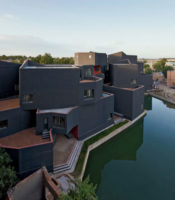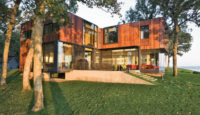Though based in Madrid, where he graduated from the School of Architecture at the Technical University of Madrid in 2002, José María Sánchez García developed his career in his native Extremadura, a relatively poor rural region in western Spain. There he has won a number of competitions for public projects in which the conservation of the region’s historic monuments and natural environment are constant themes. In response, his designs often hover over or burrow under their sites. More importantly, his work seeks a formal solidity and directness that interacts with its privileged surroundings as a forceful presence that is never loud in tone.
His attraction to solid geometries was evident in his first private commissions. For the Pronat office building in his hometown of Don Benito, he set the protruding volumes of its southern facade on a large concrete esplanade that underscores the sharply modeled play of light and shadow. For other projects, such as a creative-arts workshop for teenagers in a former water cistern, he has literally drilled through thick concrete and masonry walls to open points of access and light, in a kind of architectural piercing.
He is currently building a publicly sponsored hotel, or hospedería, within the packed-earth bastions of Luna Castle, a National Monument in Alburquerque, slicing through the stone for exterior views. Similarly, Sánchez García is adapting another historic site, the fortified 16th-century convent and military hospital of San Juan de Dios in Olivenza, for use as a hospedería by “clawing” narrow cuts out of packed-earth ramparts that surround the old structure to accommodate guest-room modules. Each room is illuminated by two patios: a light well against the exterior stone wall of the ramparts, and a larger space overlooking the courtyard around the central building. Between the rooms, fingers of packed earth, 18 feet high, house baths and services.
Some of Sánchez García’s projects practically skim over delicate sites. When devising a center for rural sports in Guijo de Granadilla in the province of Cáceres near Portugal, he organized a large program into a ring structure 2,000 feet in circumference and raised it on pillars above the flood level of an adjacent reservoir. Seen at close range, the building curves away from view, disappearing amid the trees, while its perfect geometry organizes the landscape around it.
In Mérida, a city rich in Roman monuments, he is wrapping the urban plaza around the Temple of Diana in a structure, L-shaped in section, that floats on slender pillars over the original ground level uncovered by archaeologists. In this competition-winning design, the floor of the structure forms a promenade, and its plain walls and openings discretely house activities, such as cafés and a visitors’ center, designed to bring the space to life. According to Sánchez García, “The jury was looking for a syntax, a set of rules that could respond to the changes that came up as the work advanced. The structure forms a clean, neutral facade, without references, but with the massiveness of Roman architecture.”
A stint at the Spanish Academy in Rome contributed to Sánchez García’s interest in “architecture as something massive that is hollowed out,” but he traces this affinity more intimately to the spaces of his childhood. “I always lived in a house with vaulted rooms. My bedroom had no windows. It was one of those traditional alcoves that opened on a corridor for ventilation.”
At the same time, he affirms that the perspective offered by Madrid has been crucial to his professional formation, particularly the example of the architect and teacher Alberto Campo Baeza, who instilled in him the importance of “rigor.” “You can be very original and take a step forward with every project, but without forgetting the discipline of our profession, which in the end is about knowing how to build, to be coherent, and not get caught up in passing fads.”




















Post a comment to this article
Report Abusive Comment